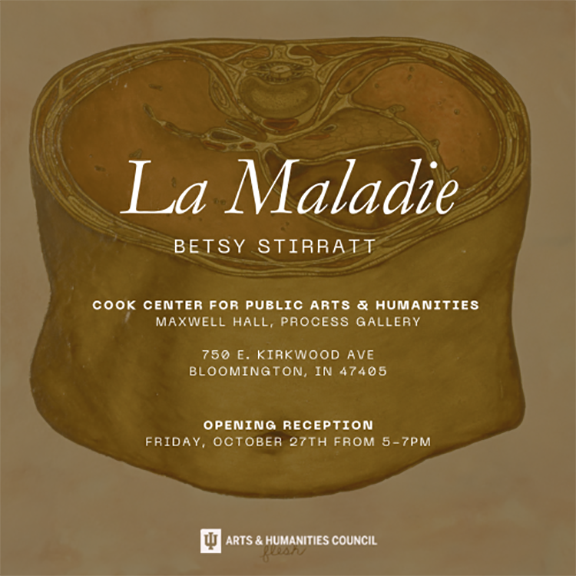Opening Reception: October 27 from 5–7pm
Exhibit Dates: October 27, 2023–January 5, 2024. Free and open to the public.
From the artist, Betsy Stirratt:
“The paintings and objects are part of a series called “La Maladie” that I completed between 1988 and 1995. The works address our underlying revulsion to disease and decay and the inevitable progression toward old age and death that is the fate of each one of us. I thought it apt to exhibit this work now because of my recent retirement and descent into “old age” and to show the progression from this early work to the more recent books and objects that I have made in the last few years.
In preparation for “La Maladie”, I researched historically important medical texts in Paris at the Library in the Faculté de médecine Paris Descartes, the National Library of Medicine in Washington and the Lilly Library at Indiana University. I was intrigued by these images because they exhibit significant beauty in their execution. The original illustrations were rendered with great skill and care, often by well-known artists of the time. They reflect the desire of the artist to accurately depict the medical condition at hand without sentimentality.
My paintings reflect a personal desire and need for knowledge about the mystery of the body and its processes, but at the same time address our fears of physical vulnerability, illness, and deformity. The text on each painting emphasizes the humanity of the images, which are statements on our physical and spiritual mortality. I try to capture both the beauty and viscerality of the original images in these works.
The wax objects were cast from moulds made from my body. They are made of beeswax, painted, and then tagged. These tags—precursors to the later books and book/objects seen here—serve as reminders of the human specimens in pathology collections.
My interest in medical illustration and collections has continued and it became possible for me to visit several pathology and anatomy archives in Europe. These visits served both to connect to the earlier paintings and objects and to learn about the display of human remains and how they are cared for. I was able to photograph in many of these collections, resulting in several handmade books that contain images of some of the items I encountered and text about the experience of viewing these challenging specimens. The more traditional bound books in the exhibit discuss the complicated ethics around the collection and display of such samples, something that is very much debated in museums today. Many museums, including the well-known Mütter Museum in Philadelphia are grappling with the ethics of display of many of their specimens, specimens that have been in the collection for over a century. The collection, display and even depiction of human bodies and remains continues to be the focus of concerns that have come to light in recent years. Historically, it was accepted that individuals and institutions could own and display human bodies and remains without prior permission or knowledge. But today the question of who owns the body is much more politically and ethically complex.
The book/objects constructed of linen cord and labels contain images from these collections and text that, when read randomly, tell the story of some of the items displayed. The combined images of the remains, sometimes intact, sometimes decaying, and the explanations that accompany them, hint at questions about our regard for life and how it is shown, interpreted, preserved, and valued. When organic remains are displayed, the context and framework chosen by institutions help shape our responses, which can sometimes be visceral and are almost without question emotional.”


